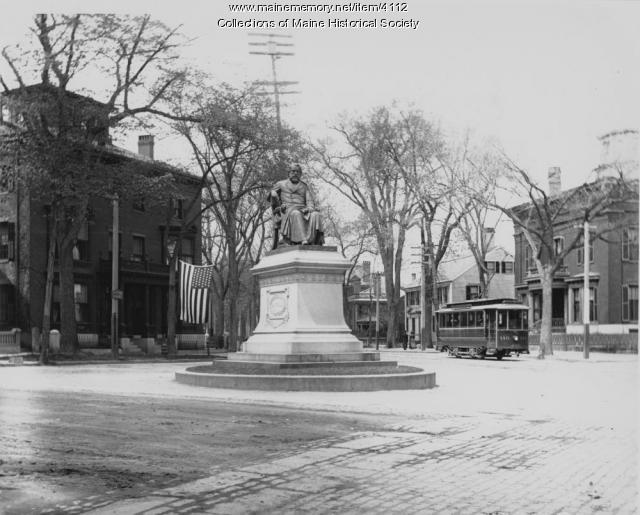Keywords: printing
Item 13495
Fryeburg Tavern printing plate, Fryeburg, ca. 1800
Contributed by: Fryeburg Historical Society Date: circa 1800 Location: Fryeburg Media: Metal, wood
Item 22843
Sanford Weekly Ledger Print Shop, ca. 1900
Contributed by: Sanford-Springvale Historical Society Date: circa 1900 Location: Sanford Media: Print from glass negative
Item 51746
175-179 Federal Street, Portland, 1924
Owner in 1924: Gannett Building Co. Use: Offices & Printing Plant
Item 99240
90-92 Gilman Street, Portland, 1924
Owner in 1924: Edwin A. Farr Use: Dwelling - Six Family
Item 151691
Portland City Hall, Portland, 1909-1912
Contributed by: Maine Historical Society
Date: 1909–1912
Location: Portland
Client: City of Portland
Architect: Carrere & Hastings Architects
This record contains 2 images.
Item 150721
Additions to Home of John J. McCarthy, Lewiston, 1936
Contributed by: Maine Historical Society Date: 1936 Location: Lewiston Client: John J. McCarthy Architect: Coombs Brothers Architects
Exhibit
Unlocking the Declaration's Secrets
Fewer than 30 copies of the first printing of the Declaration of Independence are known to exist. John Dunlap hurriedly printed copies for distribution to assemblies, conventions, committees and military officers. Authenticating authenticity of the document requires examination of numerous details of the broadside.
Exhibit
Notorious: Maine Crime in the Public Eye, 1690–1940 - Early American Printing
"… Issue of the "New-England Courant," printed by Benjamin Franklin, Boston, 1723Maine Historical Society Printing in British America started…"
Site Page
Historic Clothing Collection - Poppy print maxi skirt, ca. 1975 - Page 1 of 3
"Poppy print maxi skirt, ca. 1975 Contributed by Maine Historical Society Description A white pique printed cotton long maxi skirt with…"
Site Page
Life on a Tidal River - Bangor Site Resources
"Print. Cook, Walter L. A bicentennial look at bygone Bangor: a republication from a special series about Bangor's past in the Bangor Daily News."
Story
21st and 19th century technology and freelance photography
by Brendan Bullock
My work is a mash-up of cutting edge technology and 19th century chemistry techniques.
Story
My Vietnam service detailed in Life Magazine
by Henry B. Severance III
My company's service was documented by war photographer Catherine Leroy in Life Magazine.
Lesson Plan
Grade Level: 3-5, 6-8, 9-12
Content Area: Social Studies, Visual & Performing Arts
"In the four quarters of the globe, who reads an American book?" Englishman Sydney Smith's 1820 sneer irked Americans, especially writers such as Irving, Cooper, Hawthorne, and Maine's John Neal, until Henry Wadsworth Longfellow's resounding popularity successfully rebuffed the question. The Bowdoin educated Portland native became the America's first superstar poet, paradoxically loved especially in Britain, even memorialized at Westminster Abbey. He achieved international celebrity with about forty books or translations to his credit between 1830 and 1884, and, like superstars today, his public craved pictures of him. His publishers consequently commissioned Longfellow's portrait more often than his family, and he sat for dozens of original paintings, drawings, and photos during his lifetime, as well as sculptures. Engravers and lithographers printed replicas of the originals as book frontispiece, as illustrations for magazine or newspaper articles, and as post cards or "cabinet" cards handed out to admirers, often autographed. After the poet's death, illustrators continued commercial production of his image for new editions of his writings and coloring books or games such as "Authors," and sculptors commemorated him with busts in Longfellow Schools or full-length figures in town squares. On the simple basis of quantity, the number of reproductions of the Maine native's image arguably marks him as the country's best-known nineteenth century writer. TEACHERS can use this presentation to discuss these themes in art, history, English, or humanities classes, or to lead into the following LESSON PLANS. The plans aim for any 9-12 high school studio art class, but they can also be used in any humanities course, such as literature or history. They can be adapted readily for grades 3-8 as well by modifying instructional language, evaluation rubrics, and targeted Maine Learning Results and by selecting materials for appropriate age level.
Lesson Plan
Longfellow Studies: The Exile of the People of Longfellow's "Evangeline"
Grade Level: 6-8
Content Area: Social Studies
Other materials needed:
- Copy of Henry Wadsworth Longfellow's "Evangeline"
- Print media and Internet access for research
- Deportation Orders (may use primary document with a secondary source interpretation)
Throughout the course of history there have been many events in which great suffering was inflicted upon innocent people. The story of the Acadian expulsion is one such event. Britain and France, the two most powerful nations of Europe, were at war off and on throughout the 18th century. North America became a coveted prize for both warring nations. The French Acadians of present day Nova Scotia fell victim to great suffering. Even under an oath of allegiance to England, the Acadians were advised that their families were to be deported and their lands confiscated by the English. This event was immortalized by Henry Wadsworth Longfellow's epic poem "Evangeline", which was published in 1847.




















